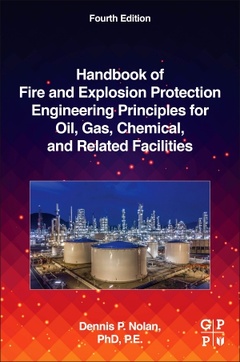Handbook of Fire and Explosion Protection Engineering Principles for Oil, Gas, Chemical, and Related Facilities (4th Ed.) for Oil, Gas, Chemical and Related Facilities
Auteur : Nolan Dennis P.

Handbook of Fire and Explosion Protection Engineering Principles for the Oil, Gas, Chemical, and Related Facilities, Fourth Edition, discusses high-level risk analysis and advanced technical considerations, such as process control, emergency shut-downs, and evaluation procedures. As more engineers and managers are adopting risk-based approaches to minimize risk, maximize profits, and keep operations running smoothly, this reference encompasses all the critical equipment and standards necessary for the process industries, including oil and gas. Updated with new information covering fire and explosion resistant systems, drainage systems, and human factors, this book delivers the equipment standards needed to protect today?s petrochemical assets and facilities.
1. Historical Background, Legal Influences, Management Responsibility, and Safety Culture2. Overview of Oil, Gas, and Petrochemical Facilities3. Philosophy of Protection Principles4. Physical Properties of Hydrocarbons and Petrochemicals5. Characteristics of Hazardous Material Releases, Fires, and Explosions6. Historical Survey of Major Fires and Explosions in the Process Industries7. Risk Analysis8. Segregation, Separation, and Arrangement9. Grading, Containment, and Drainage Systems10. Process Controls11. Emergency Shutdown12. Depressurization, Blowdown, and Venting13. Overpressure and Thermal Relief14. Control of Ignition Sources15. Elimination of Process Releases16. Fire and Explosion Resistant Systems17. Fire and Gas Detection and Alarm Systems18. Evacuation Alerting and Arrangements19. Methods of Fire Suppression20. Special Locations, Facilities, and Equipment21. Human Factors and Ergonomic Considerations22. Evaluating Concerns
AppendixA. Testing Firewater SystemsB. Reference Data
- Provides tactics on how to revise and upgrade company policies to support safer designs and equipment
- Helps readers understand the latest in fire suppression and explosion risks for a process plant in a single source
- Updates on how to evaluate concerns, thus helping engineers and managers process operating requests and estimate practical cost benefit factors
Date de parution : 10-2018
Ouvrage de 522 p.
15x22.8 cm
Thèmes de Handbook of Fire and Explosion Protection Engineering... :
Mots-clés :
Accountability; Accumulation; Activation; Air cooler fans; Air intakes; Alarm management; Alarm saturation; Alarm setting; Alarms; Alkene; Alkylation; Alkyne; Annunciation; Apathy; Arctic environments; Aromatic; Arrangement; As low as reasonably practical (ALARP); Asphalt; Attitude; Autoignition temperature (AIT); Automation; Backup power; Basic process control system (BPCS); Battery rooms; Beacons; Bearing failure; Best available control technology (BACT); Bhopal; Bimetallic strip; Blow-out; Blow-out water injection systems (BOSS); Blowdown; Blowdown capabilities; Blowout; Blowout preventers (BOPs); Boiler and pressure vessel code; Boiling liquid expanding vapor explosion (BLEVE); Bow-tie analysis (BTA); Buncefield; Buoyancy; Burn pit; Burn pits; Burner management systems (BMS); Business interruption; Butane; Bypass; Cafeterias; Calibration; Carbon dioxide systems; Catalytic cracking; Catalytic point gas detector; Catastrophic failure; Catch basin; Cementitious materials; Central processing facilities; Channel; Checklist; Chemical Safety Board (CSB); Chemical Safety and Hazard Investigation Board (CSB); Chemical hazard analysis; Chemical injection; Chemical processes; Chemical reaction; Christmas tree; Class A fires; Class B fires; Class C fires; Class D fires; Clean Air Act; Clean agent systems; Closed drain system (CDS); Closed drainage system (CDS); Color; Color coding; Combustible; Combustible vapor dispersion (CVD); Combustion; Combustion gases; Communications rooms; Complacency; Compressor; Condensate; Conduction; Congestion; Consequence modeling; Construction; Containment; Control room; Control room console; Control valves; Convection; Cooling; Cooling towers; Cost influence curve; Cost-benefit analysis; Crane access; Credible incident scenarios; Cross zoning; Crosswind
